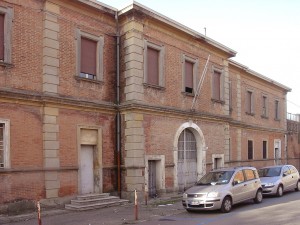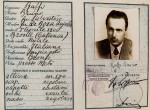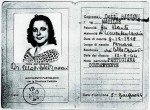Prison, Via Piangipane
Built in1912 and operational until 1992. The prison housed anti-fascists, and after 8 September 1943, it also held members of the resistance and citizens of Jewish origin, including Matilde and Giorgio Bassani. Today, it serves as the headquarters of the National Museum of Italian Judaism and the Shoah.
1.The building
The complex of the district prison in Via Piangipane consists of three distinct building blocks: the entrance building, resulting from the union of two smaller original structures, intended for the guardhouse and the custodian's residence; a building designated for detention and offices; a central body also intended for detention. The entire complex is enclosed by a double perimeter wall.
2. The place of detention
The judicial prison in Via Piangipane was built between 1908 and 1912 based on a design by engineers Bertotti and Facchini of the Civil Engineering Office. It began operating on 14 September 1912, with 104 inmates.
During the fascist ventennio (the twenty-year period of fascist rule), it became a place of detention for many anti-fascists from Ferrara. After the fall of the regime on 30 July 1943, 88 political prisoners were released.
In the aftermath of 8 September 1943, with the German occupation and the establishment of the Italian Social Republic, the prison once again filled with anti-fascists, joined by members of the resistance and Jews. On 7 October 1943, 34 people were arrested and incarcerated, including Rabbi Leone Leoni (1897-1964) and Eugenio Ravenna, the nephew of the former podestà Renzo.
On 15 November 1943, another 72 people were imprisoned, including the socialist teacher Alda Costa; some of them later became victims of the Castle Massacre. The writer Giorgio Bassani was also confined in Via Piangipane prison, arrested in May 1943 along with Matilde Bassani; both were active in the anti-fascist struggle as members of the Party of Action.
Due to bombings in 1944, the prison became unusable. It resumed its functions as a district prison from 1945 until 1992.
3. The testimony of Giorgio Bassani
"Dear Mum, I received your letters, which brought me great joy. I also heard from Valeria that you are recovering, and this is the best gift you could give me. Thank you for the exquisite dishes you send. Everything is perfect, and your skilled hand is felt everywhere. In these days, I reread War and Peace, and for some reason, I often thought of you as I turned the pages. Certainly, something of you circulates in the family scenes of that great book. And then Tolstoy's way of ridiculing his sombre Napoleon is a bit like yours, popular and enthusiastic, which gets on Dad's nerves, who aims instead for historical objectivity. In short, you are a great woman, and you have a mountain of qualities."
Excerpt from one of the letters written by Giorgio Bassani during his detention in the Via Piangipane prison between May and July 1943, in Bassani. Racconti, diari, cronache (1935-1956), a cura di Piero Pieri, Milano, Feltrinelli, 2014, p. 269
4. Place of culture
After its closure in 1992, the building was left in a state of complete abandonment until it was chosen as the location for the new National Museum of Italian Judaism and the Shoah - MEIS. The prison, a place defined by closure and segregation, thus transforms into a space dedicated to encounter and integration, the development, and dissemination of knowledge.
In November 2007, the building and the adjacent area were handed over by the Italian Public Property Agency to the Ministry for Cultural Heritage and Activities. Over the following year, the Emilia Romagna Regional Directorate, the Superintendence for Architectural and Landscape Heritage, and the Municipality of Ferrara established a working group. On one hand, it carried out the architectural recovery of the entrance building, and on the other, it focused on studying the complex and subsequently issued a call for the design of the new museum.
The restoration of the entrance building concluded with its inauguration in December 2011. Since then, it has housed the offices of the National Museum of Italian Judaism and the Shoah Foundation, responsible for managing the museum's activities, and has been a venue for cultural events, exhibitions, and conferences. After announcing an international design competition in April 2010, which saw the participation of 52 projects and was won by Studio Arco in Bologna, and the approval of the Final Project at the Services Conference on 17 December 2012, the realization of the National Museum of Italian Judaism and the Shoah continues. Currently, the ongoing construction work pertains to the central body of the building.
Bibliography
Sitography
- www.emiliaromagna.beniculturali.it/index.php?it/230/meis-museo-nazionale-dellebraismo-italiano-e-della-shoah
- www.meisweb.it/museo/edificio
- resistenzamappe.it/ferrara-fe_persecuzioni-carcere_di_via_piangipane.all
Fototeca
Related Subjects
Related Itineraries
Compiling entity
- Istituto di Storia Contemporanea di Ferrara
Author
- Federica Pezzoli
- Sharon Reichel





